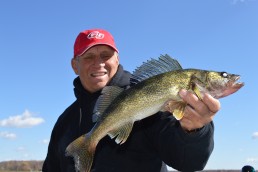Cold-Weather River Walleyes
SHARE THIS POST
Bob Jensen says that river walleyes provide great angling action during the transition from late fall to winter.
At this transitional time of year, many anglers are putting their open-water fishing gear away. But some anglers—more than you might think—are still looking forward to going fishing. They know that right now, in rivers throughout Walleye Country, many places still provide an opportunity to catch walleyes. And the number of places to catch walleyes is growing. A very knowledgeable river angler told me several years ago that the period between November 15 and December 15 is his favorite time to chase walleyes in the Midwest. And you can be successful from a boat or while wading. Here’s how to get in on the action.
“Be prepared” is probably the best advice for anglers in search of river walleyes at this time of year. The weather could be beautiful, and it could be not so beautiful. Bring proper clothing for whatever Mother Nature has in store for the day.
Some days, walleyes want a faster-moving bait; other times, they want it slow. On one of my most recent late-fall/early-winter trips, the hot setup was slowly trolling crankbaits upstream. The walleyes were on gradually tapering sand flats where the water went from about 7 to 12 feet. Hornet crankbaits are tough to beat when walleyes want to eat a crankbait. Color can be critical; a bait with some orange or chartreuse is usually a good starting point.
Many river walleye chasers start with crankbaits. They’ll hit a few spots quickly. If they get bit, they’ll keep doing what they’re doing. If the crankbait isn’t producing as well as hoped, change lures. When a slower presentation is the answer, it’s tough to beat a jig tipped with plastic. Jigs excel around wing dams and mid-river holes and current breaks. As with most fishing, keep moving until you find a pattern.
Are you enjoying this post?
You can be among the first to get the latest info on where to go, what to use and how to use it!
Wingdams are man-made structures that divert the current toward the channel. Walleyes looking for something to eat are often on the upstream side, or on the channel end, of the wingdam. If they’re not so hungry, they’ll be on the downstream side where the current is not as strong. Try a variety of spots to determine where the fish are that want to bite. Start with a jig tipped with a Rage Swimmer or a Salmo Slick Shad. Chartreuse or orange are appealing colors for walleyes almost anywhere.
When fish are schooled tightly in deeper areas, hover directly over them and put your bait close to their noses. These fish don’t want to chase a bait, but if it’s wiggling nearby, they’ll often eat it. The Tikka Mino is a fairly new bait that these fish haven’t seen much of yet, but when they do see it, they’re liking it.
At times, you’ll get a flurry of activity early or late in the day, but much of the time, the best bite will be from mid-morning to mid-afternoon. If you like to catch walleyes, you owe it to yourself to investigate this opportunity if you haven’t already done so. This is a good way to lengthen your open-water fishing season.
For more insight and tips for fishing throughout the year, check out the articles in every issue of MidWest Outdoors, available by subscribing on our website.
MWO
SHARE THIS POST
You may also like...
Nothing found.
Did you enjoy this post?
You can be among the first to get the latest info on where to go, what to use and how to use it!
Bob Jensen
To see the latest episodes of “Fishing the Midwest” television, new fishing-related tips and articles from the past, visit fishingthemidwest.com. Follow them on Facebook @fishingthemidwest for fishing information and entertainment.
